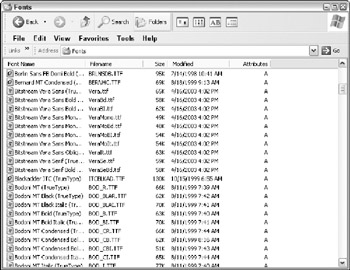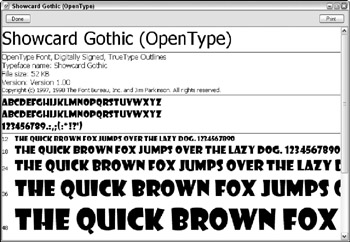Using Fonts
The first printers that appeared needed to include fonts within the printer, but now software can generate any installed system font on the printer. Windows ships with a huge selection of fonts, but you can add new fonts to your system as needed.
To add new fonts to your system, follow these steps:
-
Download or locate new fonts from a CD.
-
Copy the new fonts into the Windows/Fonts directory or into the Fonts folder in the Control Panel.
-
After the font file is added to the Fonts directory, the new font is automatically available to all applications.
| Caution | Many viruses are disguised as downloadable fonts. Be sure to verify the font's source before installing any downloaded fonts on your system. |
All the fonts that are installed on a system can be used within the installed applications such as the word processors and desktop publishing packages. The installed Windows fonts are located in a single place that you can access using the Fonts option in the Control Panel, as shown in Figure 35.11.

Figure 35.11: All system fonts appear in the Fonts folder in the Control Panel.
| Note | You can change the look of the Fonts folder between Large Icons, List, Similarity, and Details using the buttons at the top of the Fonts folder. |
If you want to see what a specific font looks like you can right-click a font from the Fonts folder and select Open to see the font in a sample window, as shown in Figure 35.12, or you could select to print the selected font.

Figure 35.12: The Open pop-up menu displays a sample of the selected font.
Several different types of fonts are available, but they can all be used within Windows. Early fonts were created from bitmaps, and these fonts required a separate bitmap for each font size to reduce distortion when the font changed sizes. You can still use bitmap fonts, but you shouldn't resize them or the text will appear distorted.
Over time, scalable fonts developed. These fonts were defined using vectors (mathematically defined curves) that could be scaled to any size without losing their shape. This resulted in significantly smaller font sizes and fonts that could be printed at almost any resolution while still retaining legibility.
These different scalable types include the following:
-
Type 1 fonts: Adobe created Type 1 fonts, which were initially supported on Macintosh systems.
-
TrueType fonts: TrueType fonts were scalable fonts developed for Windows computers.
-
OpenType fonts: OpenType is a format that works on both Macintosh and Windows computers.
OpenType fonts also support Unicode, which is an extended set of characters that includes space for characters used in other languages such as Hebrew, Greek, Japanese, Chinese, and so on.
EAN: 2147483647
Pages: 372